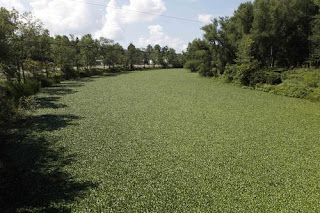 |
| Present range of water chestnuts |
The plant can produce 15 nuts per season and these sink to the bottom of the river or lake and can remain viable for up to twelve years. Impressive biological engineering there. The plants cluster together forming dense mats that can deplete oxygen levels, effectively starving out the native species, and hinder navigation.
And we do mean hinder. Here's how water chestnuts have taken over Tonawanda Creek in Buffalo:
Here's Swan Lake in New York, before last year's restoration efforts:

And here it is on Boston's own Charles River, in the "Lake District" around Newton.
In the late 1990s, the Lakes District of the Charles River faced a water chestnut problem comparable to today's. The state spent over $600,000 over five years and nearly eradicated the problem through a mechanical harvesting program before the money ran out. The few remaining plants rapidly recolonized the region and by 2011 had covered nearly 70 acres. The current restoration plan, spearheaded by the Charles River Watershed Association, is to get a bunch of volunteers together and go out in canoes and pull the water chestnuts by hand.
 |
| On our way to remove water chestnuts |
You grab the rosettes and then pull slowly so that the roots come out without breaking. Sometimes you get enormous clumps. Sometimes the roots break. It's almost a zen thing -- how slowly but firmly can you pull so that the root stays intact?
Our canoe did pretty good. We hauled in 19 baskets in just over two hours. So far this summer, 19,000 lbs of water chestnuts have been hauled in! Unfortunately, it looks like we barely made a dent and I fear that next year, the channels we canoed through will be matted over with water chestnuts.
In just over a week's time, the water chestnuts will be dropping their seeds and the removal season will be over, so if you want to help out before then, get in touch with the water chestnut coordinator or call 781-788-0007 x235 to sign up for a date (groups and private events welcome -- everything is provided except your time and energy!)
| A volunteer with a handful of water chestnuts |
You can find out additional information about this invasive weed and the plan to restore the Lakes District here. The CRWA has prepared an informative brochure and the state of Massachusetts has also prepared an information sheet. If you're a boater, you probably know to remove and dispose of all weeds on your propeller. Here's a reminder, just in case:





This comment has been removed by a blog administrator.
ReplyDeleteThis comment has been removed by a blog administrator.
ReplyDeleteThis comment has been removed by a blog administrator.
ReplyDeleteThis comment has been removed by a blog administrator.
ReplyDeleteThis comment has been removed by a blog administrator.
ReplyDeleteThis comment has been removed by a blog administrator.
ReplyDeleteThis comment has been removed by a blog administrator.
ReplyDeleteThis comment has been removed by a blog administrator.
ReplyDelete